Contact us now, we are always here for service
Ameri glass bottles, Since 1968. Your custom glass containers & stock glass container items wholesale specialist. Our customer service is always online 24/7/365.
Follow Us:
70cl vs 750ml Glass Bottles: Understanding Differences
2024-10-28 16:13:43Table of Contents
For liquor and beverage industry businesses worldwide, bottle sizes play more than simply packaging decisions; they play an essential part in consumer perception, regulatory compliance and brand identity. Two prominent bottle sizes in particular are 70cl (700ml) and 750ml bottles which hold particular relevance across regions – each having specific applications or benefits depending on usage or region regulations – making this blog post invaluable in informing your decision making processes and providing relevant knowledge.
Difference Between 70cl and 750ml Bottles
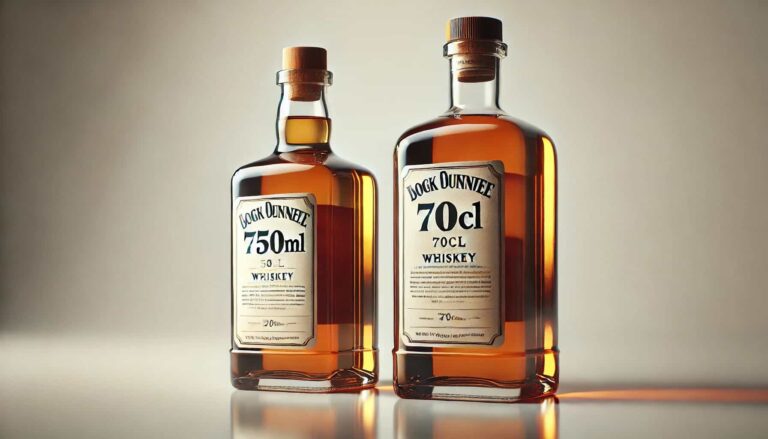
70cl and 750ml bottles may appear similar, yet each serves different functions within industry. Here is their explanation:
Conversion: One 70cl bottle equals 700ml while 750ml bottles are sometimes known in America as “fifths”, or as standards.
Historical Context: For decades now, the U.S. liquor regulations from the late 19th century have dictated 750ml bottles as standard bottles; in Europe however, 70cl has become the go-to size because EU regulations strive for consistency within spirits markets using their metric system, while American drinkers still prefer imperial units like the 750ml option.
How many Ounces are there in a 750ml glass bottle?
When trying to determine how many ounces are in a 750 ml glass bottle, you’re essentially looking at a standard measurement in the world of beverages. A 750 ml bottle, commonly found in wine and liquor stores, holds approximately 25.36 ounces.
This size is prevalent because it aligns with the typical volume of a wine or spirit bottle. For those curious about how much they can pour from one of these bottles, it’s noteworthy that a standard drink is often calculated as about 5 ounces of wine. Therefore, a 750 ml bottle contains around five 5-ounce servings.
Here’s a quick breakdown:
750 ml = 25.36 ounces
Standard Wine Pour = 5 ounces
Servings per Bottle = Approx. 5 (5-ounce pours)
Understanding these conversions can be particularly helpful whether you’re planning a dinner party, stocking a bar, or just curious about how many servings you might get from your favorite bottle.
Regional Preferences and Regulatory Standards
European Market
Under European regulations, spirits sold within its boundaries must be packaged in 70cl bottles for efficient manufacturing processes and consumer experience. Adherence to such rules has made compliance crucial when entering any EU market; consequently making the 70cl bottle size one of Europe’s premier choices.
EU Standardization Sizes for Liquor and Spirits
The European Union enforces specific bottle sizes to ensure consistency and facilitate trade across member states. Here’s a comprehensive look at the standard sizes:
100 ml
200 ml
350 ml: Although not as common, this size is permitted in Europe alongside the preferred Nordic round 375 ml glass bottle.
500 ml (50 cl): This classic design is particularly favored by whisky distilleries, reflecting a new trend for distilled whisky spirits.
700 ml (70 cl): This is the EU legal size for most distilled vodka, gin, brandy, tequila, and spirits, making it a common sight on liquor shelves across distributors and retailers.
1000 ml (100 cl)
1500 ml
1750 ml
2000 ml
These standardized sizes highlight the EU’s commitment to uniformity in the spirits market, ensuring that both consumers and manufacturers operate within a predictable framework. This approach aids in streamlining production and distribution, ultimately enhancing the consumer experience across the European market.
United States Market
In general, spirits and wines sold in the U.S. market typically come in bottles measuring 750ml in volume as this size aligns well with consumer preferences and historical norms. Manufacturers have more freedom in exploring various bottle sizes; although 750ml remains widely accepted across North America. Contrary to EU regulations which strictly limit bottle size variations for spirits and wines sold here. This provides producers with additional market positioning options.
Understanding the full spectrum of legally allowed bottle sizes can be crucial for both consumers and producers. Here are the most common liquor bottle sizes you’ll encounter in the United States:
50 ml (1.7 oz): Often referred to as a nip or miniature, this size is perfect for sampling or travel.
100 ml (3.4 oz): Equivalent to a quarter of a pint, this size is less common but still within regulations.
200 ml (6.8 oz): Comparable to a half pint, these bottles offer a middle ground for those looking for something more than a single serving.
375 ml (12.7 oz): Known as a ‘half bottle,’ this size is popular for those who want to enjoy a moderate amount without committing to a full bottle.
750 ml (25.4 oz): Also called a ‘fifth,’ this is the standard size most widely accepted by distilleries and consumers alike.
1000 ml (1 liter): For those who want a bit more, this larger size provides additional value.
1750 ml (1.75 liters): Often used for craft alcohol, this large size is ideal for gatherings and special occasions.
It’s important to note that while there is flexibility, not all sizes are permissible. For example, a 500 ml bottle is not allowed under U.S. regulations, and those aiming to introduce new products should carefully check legislation regarding distilled alcohol bottling.
This knowledge is essential for anyone involved in the spirits industry or simply wishing to understand the market better, ensuring compliance and meeting consumer expectations.
Metric vs. Imperial Measurement Systems
The global trend towards using the metric system, particularly within Europe and notably affecting bottle sizes such as 70cl bottles is unmistakeable; yet certain sectors still employing imperial measurements align with standard bottle sizes of 750ml bottles in America – this discrepancy in measurement standards means international brands often need to adjust their packaging depending on which market their target consumers reside in.
Practical Applications of Each Bottle Size
Common Uses for 70cl Bottles
The 70cl bottle is widely used across Europe for spirits such as whisky, gin and other liqueurs; making this size highly practical and user friendly; popular both as personal consumption as well as gift items. European consumers find the 70cl volume to be ideal as an everyday companion that doesn’t overwhelm with bulkiness.
Common Uses for 750ml Bottles
North Americans typically favor the 750ml bottle for wine, whiskey and spirits consumption. With its slightly larger capacity offering better value for money and ideal sharing among small groups. Wine enthusiasts also frequently associate its use as symbolizing quality and tradition – it holds just enough for an eventful group gathering or special celebration!
Market Trends and Preferences Analysis
Recent trends reveal a strong preference among younger consumers to opt for smaller bottles, in particular among those who value sampling and variety over quantity. With ready-to-drink cocktails becoming more convenient and customizable for consumers alike, both sizes serve different functions; with 750ml meeting value/tradition needs while 70cl providing personal use or gifting needs at compact packaging levels.
Bottle Design and Shape Variations
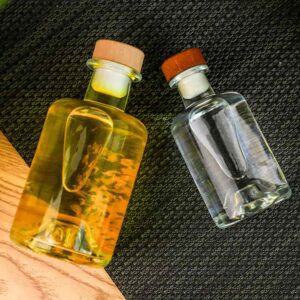
Bottle design plays an integral part in consumer appeal and brand perception, impacting both perception and choice. Common shapes for 70cl and 750ml bottles are circular, squared rectangular or long necked designs – each offering specific advantages:
Round Bottles:
Round bottles have become the go-to containers for both wine and spirits, presenting timeless aesthetics.
The Round bottles such as Boston round liquor bottles are a popular choice in the spirits industry, recognized for their distinct round cylindrical shape and gently curving shoulders. This elegant design not only makes them visually appealing but also ensures ease of use during bottling and labeling processes.
Square and Rectangular Bottles:
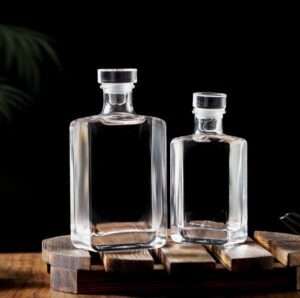
Square bottles stand out on store shelves with their modern aesthetic, adding an eye-catching flair. Plus, square designs tend to offer greater space efficiency during storage and transport.
How Do Square Liquor Bottles Appeal to Younger Consumers?
Square liquor bottles are captivating the attention of younger consumers by offering a refreshing departure from traditional designs. Here’s why they resonate so well with this demographic:
1. Unique Shelf Presence: Unlike the conventional round bottles, square designs offer a distinctive look that immediately catches the eye. Their defined edges and sleek lines create a modern aesthetic that appeals to those who value originality and style.
2. Trendy and Innovative Design: Younger consumers often seek products that break away from the norm. Square bottles embody innovation and trendiness, making them an ideal choice for individuals who want their purchasing decisions to reflect cutting-edge style.
3. Efficient Use of Space: The geometric design of square bottles optimizes shelf space, both in stores and at home. This practical aspect appeals to younger individuals who might be navigating the challenges of smaller living spaces.
3. Visual Impact: In an age where visual appeal can influence buying decisions, the sharp and edgy appearance of square bottles can stand out in social media posts, further enticing younger audiences who enjoy sharing their experiences online.
By combining aesthetic appeal with practical advantages, square liquor bottles effectively attract the attention and admiration of younger consumers, setting new trends in the world of spirits packaging.
Long-Neck Bottles:
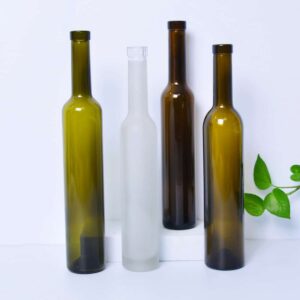
Long-neck bottles offer a luxurious appearance and are often found in luxury products like whiskey or gin. These bottles are not only aesthetically pleasing but also designed for practicality. Their thin and slim tall shape makes them easy to hold, adding a touch of elegance to any spirit.
Available in various sizes, such as 500 ml, 70 cl (700 ml), and 750 ml (75 cl), these bottles provide distilleries with versatile options to suit different product lines. The frosted glass variant further enhances their appeal by presenting an image of purity and smoothness while protecting the spirits from harmful UV light.
Moreover, personalized long-neck bottles can significantly boost a brand’s market presence. By drawing consumer attention through their unique design, these bottles add value and can encourage customers to take a closer look at the spirits they contain.
Swing Top Liquor Bottles
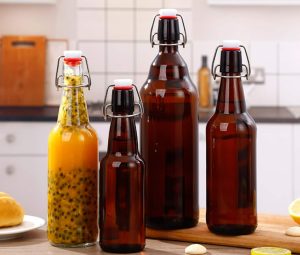
Swing top liquor bottles stand out for several compelling reasons, each contributing to their rising popularity among enthusiasts and collectors alike. Here’s a deeper look into what sets them apart:
Airtight Sealing for Enhanced Flavor
One of the primary features of swing top bottles is their airtight sealing mechanism. This reliable seal ensures that your liquor and spirits maintain their integrity and taste over time. By preventing air from entering, these bottles help preserve the full, rich flavors of your beverage, offering a fresher taste with each pour.
Nostalgic Charm and Craftsmanship
These bottles aren’t just about functionality—they’re a nod to the art of making and presenting drinks. Available in vintage styles, swing top bottles evoke a sense of nostalgia and craftsmanship. The retro appeal is perfect for evoking a classic, timeless look that suits both modern and traditional settings.
Versatile Sizing Options
Swing top bottles come in a variety of sizes, from as small as 60ml to as large as 1 liter. This versatility allows you to choose the perfect size for your needs, whether you’re bottling homemade infusions, small-batch spirits, or simply looking to use them for decorative purposes. The range of options ensures there’s a swing top bottle for every occasion and setting.
Sustainable and Reusable
In an era focused on sustainability, swing top bottles are an eco-friendly choice. Their sturdy design means they can be reused time and again, reducing waste and promoting environmentally conscious consumption. Simply clean and refill, and you’re ready for the next gathering or personal enjoyment.
By combining practical benefits with an aesthetic that harks back to traditional craftsmanship, swing top liquor bottles offer a unique and attractive option for anyone interested in enhancing their drinking experience.
In the dynamic world of spirits, custom glass bottles hold a pivotal role, driving both consumer interest and brand differentiation. With an urgent demand from vodka, whiskey, brandy, gin, tequila, and rum producers, unique bottle designs have become essential. Consumers are no longer just looking for rich flavors; they crave innovative and interesting packaging that stands out on the shelves.
Individual custom bottle designs give brands an advantage in an oversaturated market, and custom glass bottles provide a unique opportunity to reflect brand identities. By capturing the essence of a brand visually, these bottles leave an indelible mark with consumers, giving brands an edge against competitors.
Moreover, decorative glass bottles are not just about aesthetics; they are a powerful tool for business growth. By enhancing product appeal, they can significantly contribute to expanding a spirit business, drawing in new customers and retaining loyal ones. Thus, custom glass bottles are instrumental in shaping market trends and consumer perceptions in the liquor industry.
What Are Some Less Common Sizes of Alcohol Bottles?
When it comes to alcohol bottles, most are familiar with the standard sizes like pints and fifths. However, there are unique and intriguing bottle sizes that stand out due to their lesser frequency on the market. These sizes not only provide novelty but also serve special purposes, often reserved for memorable events or niche collections. Here’s a closer look at some of these unusual sizes and what they represent:
Nip (Mini)
The nip, also known as a mini, is compact and convenient. Holding 50 milliliters (approximately 1.7 ounces), it’s perfect for individual servings or sampling. This size typically equals one standard shot, making it a popular choice for travelers or promotional giveaways.
Quarter Pint
Although the name suggests a direct quarter of a pint, a quarter pint actually contains 100 milliliters or 3.4 fluid ounces. This size holds about two shots of alcohol, convenient for a small gathering or a personal stash.
Half-Pint
The half-pint is often mistaken for being precisely half of a full pint. However, it holds 200 milliliters (or 6.8 ounces), the equivalent of about four shots. This size is particularly popular for personal consumption or sharing with a friend.
Magnum
For those who enjoy hosting larger gatherings, the magnum bottle is a showstopper. It holds 1.5 liters (or 50.7 ounces), accommodating around 34 shots. This size can help cater to bigger parties without needing constant refills.
Double Magnum (Jeroboam)
Taking things up a notch, the double magnum, also known as a jeroboam, contains a hefty 3 liters (or 101.4 ounces). With room for approximately 67 shots, it’s ideal for grand celebrations and ensures there’s plenty to go around.
Rehoboam
The rehoboam is often reserved for truly special occasions, as it boasts a massive 4.5-liter capacity (or 152.2 ounces). This bottle holds over 101 shots, making it a centerpiece for events that warrant an impressive display of generosity.
These less common sizes of alcohol bottles not only offer a range of quantity options but also enhance the drinking experience for different occasions. Whether you’re sampling, sharing with close friends, or hosting hundreds, choosing the right bottle size can elevate any gathering into something memorable.
Why Are Glass Liquor Bottles Diverse in Shapes Compared to Wine Bottles?
The fundamental difference between glass liquor bottles and wine bottles stems from the manufacturing process, customization options, and consumer expectations.
Unique Manufacturing Processes
Manufacturing liquor bottles involves distinct processes, including specialized tooling and molding techniques. These techniques enable the creation of a wide variety of shapes and sizes, accommodating the diverse branding needs of spirits like vodka, whiskey, and rum. Each brand seeks to stand out on the shelf, using unique bottle designs to capture consumer attention.
In contrast, wine bottles typically follow a more standardized production process. This often results in a limited variety of shapes, primarily because traditional wine consumer expectations lean towards uniformity. The classic silhouette of wine bottles, whether Bordeaux or Burgundy-style, reinforces this consistency.
Customization and Production Costs
Customization plays a significant role in bottle design diversity. For the spirits industry, custom bottle production is feasible for orders as small as 10,000 units. This allows for greater experimentation with design, encouraging brands to innovate and create memorable bottle shapes.
Meanwhile, wine bottle customization requires significantly higher minimum orders—usually between 200,000 to 300,000 units. This high threshold makes extensive customization less practical for smaller wineries, consequently leading to more conventional bottle designs.
Marketing and Aesthetic Appeal
Liquor brands often leverage distinctive bottle shapes as a core component of their branding strategy. An unusual bottle design can symbolize quality or craftsmanship, often aligning with the unique personality or story a brand wishes to convey.
On the other hand, wine bottles rely more on labels and color variations to communicate quality and heritage. The experience of wine drinking is generally more tied to tradition, which is reflected in their uniform bottle appearances.
In summary, the diversity in glass liquor bottles compared to wine bottles is primarily driven by different manufacturing processes, customization limits, and marketing strategies. These elements combine to create the visually distinct, varied bottle designs seen in the liquor industry today.
Practical Considerations for Manufacturers and Consumers
Servings and Consumer Choice
A 70cl bottle typically holds 14 standard 1.5-ounce shots while a 750ml bottle typically accommodates 17 shots; although these differences might seem minor, their significance could impact consumer decisions depending on usage; for example 750ml bottles might be more suitable for events while 70cl bottles might better suit personal use or gift giving.
Cost Implications for Manufacturing
Manufacturers need to factor packaging, labeling and regulatory compliance into their production costs when choosing between 70cl or 750ml bottles for production. This decision could affect these expenses since different molds, labels and logistics may be needed for each region; adapting products for global consumers’ standards can become complex and expensive.
Storage and Transportation solutions
Storage-wise, the 70cl bottle provides an advantageous smaller footprint – perfect for spaces with limited room! Transport is compatible with standard packaging but differences in weight or volume could affect shipping costs significantly; manufacturers usually factor these logistical aspects when selecting their bottle sizes.
Conclusion
Selecting between 70cl or 750ml bottles requires understanding their respective uses and market regulations. A 70cl bottle is generally popular among European consumers due to meeting regulatory standards; these bottles make ideal gifts or personal consumption options. In contrast, 750ml bottles tend to dominate American markets since their larger volume makes them desirable at gatherings or other small events.
Picking out an ideal bottle size involves considering not only volume and regulations but also design, storage, transportation and brand image considerations. When entering new markets, custom bottle solutions may provide optimal solutions that address local demands while strengthening brand perception and building an ideal image for their product/brand.
Ameri Glass Bottle is a professional custom glass container manufacturer provides expert glass bottle customization services, from designing custom 70cl EU market bottles to U.S. market options ranging from 750ml up. For further insight into bottle sizes please see our comprehensive guide of liquor bottle sizes; or reach out directly so we can find tailored solutions together.

